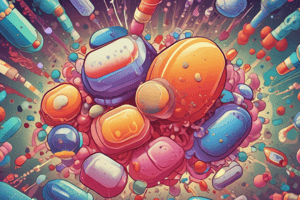Podcast
Questions and Answers
Why is it difficult for β-lactam antibiotics to reach their targets in gram-negative bacteria?
Why is it difficult for β-lactam antibiotics to reach their targets in gram-negative bacteria?
- The porins are protein channels that block β-lactam antibiotics
- The PBPs are hidden behind the porins
- The outer membrane is impermeable to β-lactam antibiotics (correct)
- The peptidoglycan layer is too thick
What is the functional group attached to the 1st carbon atom in the beta-lactam ring of penicillins?
What is the functional group attached to the 1st carbon atom in the beta-lactam ring of penicillins?
- CH3
- O
- NH
- COOH (correct)
What is the role of porins in facilitating the action of β-lactam antibiotics?
What is the role of porins in facilitating the action of β-lactam antibiotics?
- They enhance the activity of β-lactam antibiotics
- They provide a channel for β-lactam antibiotics to diffuse through the outer membrane (correct)
- They break down the peptidoglycan layer
- They inhibit the activity of PBPs
Which of the following is a characteristic of natural penicillins?
Which of the following is a characteristic of natural penicillins?
What is the primary reason why a β-lactam antibiotic cannot kill a bacterium?
What is the primary reason why a β-lactam antibiotic cannot kill a bacterium?
What type of bacteria have relatively exposed PBPs and peptidoglycan layers?
What type of bacteria have relatively exposed PBPs and peptidoglycan layers?
What is the R group in the structure of penicillins?
What is the R group in the structure of penicillins?
What is the name of the protein channels in the outer membrane that β-lactam antibiotics must diffuse through?
What is the name of the protein channels in the outer membrane that β-lactam antibiotics must diffuse through?
Which of the following is NOT a type of penicillin?
Which of the following is NOT a type of penicillin?
What is the consequence of a β-lactam antibiotic being unable to reach its target in a bacterium?
What is the consequence of a β-lactam antibiotic being unable to reach its target in a bacterium?
What is the combination of ampicillin with sulbactam used for?
What is the combination of ampicillin with sulbactam used for?
Which of the following penicillins is an oral agent?
Which of the following penicillins is an oral agent?
What is the function of β-lactamase inhibitors in penicillins?
What is the function of β-lactamase inhibitors in penicillins?
What is the term for the combination of a penicillin with a β-lactamase inhibitor?
What is the term for the combination of a penicillin with a β-lactamase inhibitor?
What is the primary limitation of antistaphylococcal penicillins in terms of their spectrum of activity?
What is the primary limitation of antistaphylococcal penicillins in terms of their spectrum of activity?
Which of the following bacteria is not typically treated with antistaphylococcal penicillins?
Which of the following bacteria is not typically treated with antistaphylococcal penicillins?
What is the main reason why antistaphylococcal penicillins are not used to treat enterococcal infections?
What is the main reason why antistaphylococcal penicillins are not used to treat enterococcal infections?
Which of the following is a characteristic of antistaphylococcal penicillins that limits their spectrum of activity?
Which of the following is a characteristic of antistaphylococcal penicillins that limits their spectrum of activity?
What is the primary use of antistaphylococcal penicillins?
What is the primary use of antistaphylococcal penicillins?
Which of the following antibiotics is no longer commercially available?
Which of the following antibiotics is no longer commercially available?
What is the term for the group of antibiotics that includes nafcillin, oxacillin, and dicloxacillin?
What is the term for the group of antibiotics that includes nafcillin, oxacillin, and dicloxacillin?
Why are antistaphylococcal penicillins less effective against streptococci?
Why are antistaphylococcal penicillins less effective against streptococci?
What is the reason for piperacillin's name?
What is the reason for piperacillin's name?
Compared to aminopenicillins, extended-spectrum penicillins are more resistant to cleavage by which type of enzymes?
Compared to aminopenicillins, extended-spectrum penicillins are more resistant to cleavage by which type of enzymes?
What is the activity of extended-spectrum penicillins against gram-positive bacteria?
What is the activity of extended-spectrum penicillins against gram-positive bacteria?
What is the activity of piperacillin against Pseudomonas aeruginosa?
What is the activity of piperacillin against Pseudomonas aeruginosa?
Which of the following bacteria is susceptible to the β-lactamases of staphylococci?
Which of the following bacteria is susceptible to the β-lactamases of staphylococci?
What is the activity of extended-spectrum penicillins against anaerobes?
What is the activity of extended-spectrum penicillins against anaerobes?
What is the difference between piperacillin and ticarcillin?
What is the difference between piperacillin and ticarcillin?
Which of the following bacteria is not typically susceptible to extended-spectrum penicillins?
Which of the following bacteria is not typically susceptible to extended-spectrum penicillins?
What is the primary action of penicillins in bacteria?
What is the primary action of penicillins in bacteria?
Which type of bacteria are natural penicillins most active against?
Which type of bacteria are natural penicillins most active against?
What is the effect of adding a β-lactamase inhibitor to an aminopenicillin?
What is the effect of adding a β-lactamase inhibitor to an aminopenicillin?
What is the characteristic of extended-spectrum penicillins compared to aminopenicillins?
What is the characteristic of extended-spectrum penicillins compared to aminopenicillins?
What is the effect of using extended-spectrum penicillins in combination with β-lactamase inhibitors?
What is the effect of using extended-spectrum penicillins in combination with β-lactamase inhibitors?
Which type of bacteria are antistaphylococcal penicillins useful in treating infections caused by?
Which type of bacteria are antistaphylococcal penicillins useful in treating infections caused by?
What is the spectrum of activity of extended-spectrum penicillins when used in combination with β-lactamase inhibitors?
What is the spectrum of activity of extended-spectrum penicillins when used in combination with β-lactamase inhibitors?
What is the characteristic of aminopenicillins compared to natural penicillins?
What is the characteristic of aminopenicillins compared to natural penicillins?
What is required for the synthesis of new proteins in bacteria?
What is required for the synthesis of new proteins in bacteria?
What is the estimated energy required to add a single amino acid to a growing protein?
What is the estimated energy required to add a single amino acid to a growing protein?
What is the first step in the synthesis of new proteins in bacteria?
What is the first step in the synthesis of new proteins in bacteria?
What is the role of special bacterial enzymes in the synthesis of new proteins?
What is the role of special bacterial enzymes in the synthesis of new proteins?
What is the result of the synthesis of new proteins in bacteria?
What is the result of the synthesis of new proteins in bacteria?
Why is protein production in bacteria amenable to inhibition by antibiotics?
Why is protein production in bacteria amenable to inhibition by antibiotics?
What do bacteria acquire from the human body?
What do bacteria acquire from the human body?
What is the purpose of invading the human body for bacteria?
What is the purpose of invading the human body for bacteria?
What is the term for the potential energy stored in the gradient between the interior and exterior of the cell?
What is the term for the potential energy stored in the gradient between the interior and exterior of the cell?
What is the direction of proton flow down the gradient in bacterial cells?
What is the direction of proton flow down the gradient in bacterial cells?
What is the result of protons flowing down the gradient through the cytoplasmic membrane?
What is the result of protons flowing down the gradient through the cytoplasmic membrane?
What is the energy source used to power the synthesis of RNA during transcription?
What is the energy source used to power the synthesis of RNA during transcription?
What is the enzyme complex used by bacteria to synthesize RNA during transcription?
What is the enzyme complex used by bacteria to synthesize RNA during transcription?
What is the type of RNA synthesized during transcription in bacterial cells?
What is the type of RNA synthesized during transcription in bacterial cells?
What is the process by which the information in the DNA of a bacterial gene is used to synthesize an RNA molecule?
What is the process by which the information in the DNA of a bacterial gene is used to synthesize an RNA molecule?
What is the ultimate product of the process of protein production in bacterial cells?
What is the ultimate product of the process of protein production in bacterial cells?
What is the role of THF in bacterial synthesis?
What is the role of THF in bacterial synthesis?
Why is the THF synthetic pathway an attractive target for antimicrobial compounds?
Why is the THF synthetic pathway an attractive target for antimicrobial compounds?
What is the consequence of twisting one end of the DNA while holding the other end fixed?
What is the consequence of twisting one end of the DNA while holding the other end fixed?
What is the role of topoisomerase enzymes in DNA replication?
What is the role of topoisomerase enzymes in DNA replication?
What is the result of supercoiling in DNA?
What is the result of supercoiling in DNA?
What is the structure of DNA that dictates the number of nucleotide pairs per helical turn?
What is the structure of DNA that dictates the number of nucleotide pairs per helical turn?
What is the function of DNA polymerase in bacterial chromosome replication?
What is the function of DNA polymerase in bacterial chromosome replication?
What is the relationship between the number of nucleotide pairs per helical turn and the relaxation of DNA?
What is the relationship between the number of nucleotide pairs per helical turn and the relaxation of DNA?
Study Notes
β-Lactam Antibiotics
- β-Lactam antibiotics cannot kill bacteria if they cannot reach the bacteria
- β-Lactam antibiotics must breach the outer membrane of gram-negative bacteria through porins
Penicillins
- Penicillins have a β-lactam ring and a thiazolidine ring
- Variable side chains can be attached to the β-lactam ring
- Examples of penicillins: penicillin G, penicillin V, nafcillin, oxacillin, dicloxacillin, ampicillin, amoxicillin
Natural Penicillins
- Natural penicillins are effective against aerobic gram-positive bacteria and anaerobic bacteria
- Natural penicillins have poor activity against aerobic gram-negative bacteria and most atypical bacteria
Antistaphylococcal Penicillins
- Antistaphylococcal penicillins are effective against staphylococcal infections
- Antistaphylococcal penicillins are less effective against streptococci and are not used to treat them
- Antistaphylococcal penicillins are inactive against MRSA and MRSE bacteria
Aminopenicillins
- Aminopenicillins have improved activity against aerobic gram-negative bacteria
- Examples of aminopenicillins: ampicillin, amoxicillin
Extended-Spectrum Penicillins
- Extended-spectrum penicillins are more resistant to cleavage by gram-negative β-lactamases
- Extended-spectrum penicillins are more active against gram-negative bacteria, including P. aeruginosa
- Examples of extended-spectrum penicillins: piperacillin, ticarcillin
- Extended-spectrum penicillins have modest activity against anaerobes
β-Lactamase Inhibitors
- β-Lactamase inhibitors can be added to extended-spectrum penicillins to extend their activity
- The addition of a β-lactamase inhibitor expands the spectrum of extended-spectrum penicillins to include most enteric gram-negative bacilli
Protein Production in Bacteria
- Protein production in bacteria involves transcription and translation, similar to human cells.
- The process requires raw materials such as RNAs, amino acids, and energy-containing nucleoside triphosphates.
Transcription
- Transcription is the process by which bacterial gene DNA is used to synthesize messenger RNA (mRNA).
- The enzyme RNA polymerase is used to accomplish transcription.
- Tetrahydrofolate (THF) is required for the ultimate synthesis of several nucleotides.
Tetrahydrofolate (THF) Synthesis
- Bacteria must synthesize THF, as they are unable to absorb folate from their diet.
- The synthetic pathway of THF is a target for antimicrobial compounds.
DNA Replication
- DNA polymerase is responsible for replicating the bacterial chromosome.
- Topoisomerases regulate supercoiling, or twisting of the DNA, during replication.
Supercoiling
- Supercoiling occurs when the DNA double helix is twisted, increasing or decreasing the number of nucleotide pairs per helical turn.
- This process is accommodated by the formation of supercoils.
Energy Requirements
- The synthesis of new proteins requires abundant amounts of building blocks and energy.
- It is estimated that the energy of three or four nucleoside triphosphates (e.g., ATP or GTP) is required to add a single amino acid to a growing protein.
Studying That Suits You
Use AI to generate personalized quizzes and flashcards to suit your learning preferences.
Description
This quiz covers the antibiotics that target the cell envelope, including β-lactam antibiotics, penicillins, cephalosporins, carbapenems, and monobactams. It also discusses the limitations of these antibiotics.





